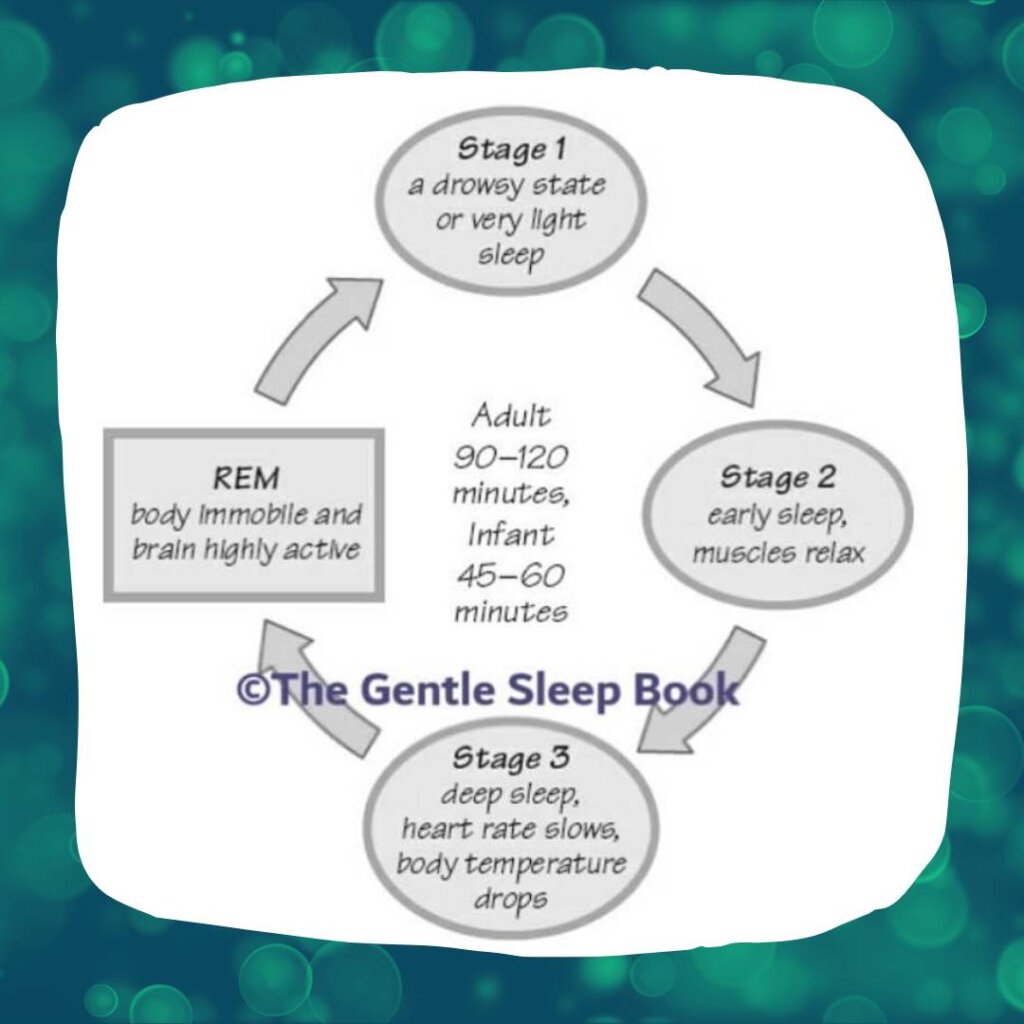How well your baby sleeps ultimately depends on three main (controllable) factors:
- Your Expectations of Good Sleep: Do you have realistic expectations about what constitutes good sleep for a baby?
- Understanding and Meeting your Baby’s Needs: How well do you know your child’s needs and wants?
- Optimised Sleep Environment: Have you created a sleep-friendly environment?
Outline:
- Benefits of a Gentle Sleep Routine.
- Implementing a Gentle Sleep Routine for Newborns.
- Sleep Setups.
- Understanding Newborns and Their Circadian Rhythm.
- Melatonin Production in Newborns.
- Tips for Supporting Circadian Rhythm Development in Newborns.
- Understanding Sleep Cycles.
- Sleep Routines for Children.
- What is the Goodnight Method?
In my article documenting the creation of the Koolá Doll, I addressed an issue close to my heart: the widespread misconceptions about baby sleep. I expressed my frustration at the prevalent misinformation and pledged to offer some constructive information that would equip new mothers with a solid foundation that I wish I had before my baby was born to help navigate this incredibly misguided topic. True to my promise, I wrote this article that will not only help manage your expectations but also equip you with strategies to support your baby’s sleep outcomes. Hopefully this article empowers you in your journey toward a more restful and rejuvenating experience for both you and your baby.
Before you get stuck into this information just ask yourself this one question: Do you as an adult have routines? – Babies also thrive on routines (not schedules- throw them out). Whatever way you choose to nurture your baby, breastfeeding to sleep or putting the baby down in their crib, any approach routine will make life much easier for you as your baby will be happier. Alter the routine when the time is right (you will feel it), flow with your baby, but keep aspects consistent. No one child is the same. Flow with their development and remove the anxiety and expectations society has connected with infant’s sleep.
YOU HAVE GOT THIS MAMA!
The Koola Mum XO
Creating a nurturing sleep routine for your newborn is a wonderful way to foster healthy sleep habits from the start. Incorporating attachment and gentle parenting principles, you can help your little one develop a positive relationship with sleep.When it comes to babies and establishing a new sleep routine, consistency is key. It is generally recommended to stick with a new sleep routine for at least 2-4 weeks before throwing in the towel!
This allows time for your baby to adjust to the new routine. Remember that each baby is unique, so it’s important to be patient and flexible in finding what works best for your little one. In this article, we’ll explore the benefits of a sleep routine for newborns through to 5 year olds, provide practical tips for implementing a gentle sleep routine, discuss the development of a newborn’s circadian rhythm, and touch on how sleep cycles work.
Benefits of a Gentle Sleep Routine:
Implementing a Gentle Sleep Routine for Newborns:

1. Create a Calm Sleep Environment:
Keep the nursery dimly lit, free from excessive noise, and at a comfortable temperature. Soft music from the Koolá™ Doll’s soundtracks or your pre-recorded song help create a soothing atmosphere.
2. Respond to Your Baby's Cues:
Newborns have different sleep needs, and their routines may be more fluid. Pay attention to your baby’s cues for sleepiness, such as eye rubbing, yawning, or becoming fussy. Respond promptly and provide gentle comfort to meet their needs and settle to sleep.
3. Establish Consistent Bedtime Cues - Sleep Associations:
Introduce gentle bedtime cues that signal it’s time for sleep. Often called “Sleep Associations” this could include:
- A warm bath
- A gentle massage
- Swaddling/PJ's
- Reading a book
- The Goodnight Method *what is this?
- Singing a lullaby
- Last Feed before bed

Consistency of time, duration and order of activities is key to help your baby associate these cues with sleep and understand what is coming next.
*Ensure the location of each activity including the bath is in a warm or low lit environment (red light is optimal).

4. Practice Responsive Parenting:
Gentle parenting involves being attuned to your baby’s needs and responding with love and care. This includes comforting your baby when they wake at night, offering reassurance, and practicing gentle methods of soothing, such as rocking or gentle touch.
5. Foster Attachment:
Encourage skin-to-skin contact, cuddling, and closeness during sleep and wake times. This helps strengthen the parent-child bond and provides a sense of security for your baby. Co-sleeping is a healthy option that has benefits for both child and mother. If this works for you then do not be afraid to co sleep – just ensure you are up to date with the safe practices first.
6. Nurture Object Permanence:
Everything the child experiences as they drift off to sleep will be expected to remain once the child wakes between sleep cycles. From the sounds, smells, bedding textures, toys, temperature, lighting and visual surroundings. Consistency in what they experience increases their sense of security and reduces anxiety when they wake between their sleep cycles.
Sleep Setups:
Co Sleeping, room sharing or separate room? Each location will require varying methods for sleep support. Newborn babies are found to be safest under the closest parental monitoring which is either co-sleeping or room sharing.

1. Co-Sleeping:
- Create a safe co-sleeping environment by ensuring a firm mattress, removing pillows, blankets, and other potential hazards.
- Establish a consistent bedtime routine to signal to your child that it's time to sleep (as mentioned above).
- Use gentle methods like skin on skin, nursing, rocking, feeding, singing or soothing sounds from the Koolá™ to help your child fall asleep.

2. Room Sharing (in a side sleeper bed or crib in the parents' room):
- Set up a designated sleep area for your child, such as a side sleeper bed or crib, that meets safety standards.
- Maintain a consistent bedtime routine to establish a sleep association and signal sleep time (as mentioned above).
- Use soothing techniques like gentle rocking, soft Koolá™ music, or feeding to help your child transition to sleep.
- Provide a comforting object, such as the Koolá™ for security.
3. Baby in their own room (in a crib or toddler bed):
- Create a calm and soothing sleep environment in your child's room, with dim lighting and a comfortable temperature.
- Implement a consistent bedtime routine that signals winding down before sleep (as mentioned above).
- Play your recorded song softly in the background - setting the timer to either 1 hour or 8 hours. If you set it to 8 hours the baby will hear the same sounds it heard while falling asleep initially.
For parents who prefer their child to sleep in a separate room and aim for their children to become “independent sleepers”, there are gentle approaches that prioritise parental support and avoid the “Cry it Out” method. These methods focus on gradually fostering independence while being responsive to the child’s needs.
- Timing is key: Place your baby in the crib when it is calm and awake. This allows them to fall asleep in their bed and reinforces the concept of object permanence. When they wake between sleep cycles, they will find themselves in the familiar sleep space, without the expectations that they would wake up in a different location.
- Gradual withdrawal method: If your baby needs more support, use a consistent method like gradual withdrawal. For example, if you currently hold and rock your baby to sleep, start by putting them in the cot slightly awake. Place your hand on the baby and provide gentle patting for comfort. Over time, transition to resting your hand on the baby without patting.
- Reduce dependency: If you're rocking your baby in a bassinet, gradually reduce the rocking motion until your baby can be laid down without needing to be rocked. The goal is to wean your baby off the interactions. Be mindful that your baby may take around 40 minutes to reach deep sleep.
- Individualize the approach: Each child is different, so trust your instincts and adapt the method that works best for your baby. Some babies may find comfort in having you nearby or engaging in subtle ways like standing over the crib or softly singing or shushing.
- Nothing is working: If your goal is to promote independence but it isnt working how you hoped some parents may choose to move their babies crib into their bedroom or to try cosleeping, especially if it leads to better sleep for both the child and parents. It is normal for infants to wake several times through the night as they experience discomforts like wet nappies, temperature changes, hunger etc. Remember, there's no right or wrong way to approach infant sleep. All you can do is ensure you have all of the knowledge and apply it. Do what works best for you and your child while ensuring their comfort and minimizing distress for all - including you!

Understanding Newborns and Their Circadian Rhythm:
Newborns are not born with a fully developed circadian rhythm, which is the internal biological clock that regulates sleep-wake cycles. This means that their sleep patterns may be irregular and influenced by external factors such as hunger, discomfort, and stimulation.
Melatonin Production in Newborns:
Melatonin is a hormone that plays a crucial role in regulating sleep. In newborns, melatonin production is not yet fully established. Instead, they receive melatonin from their mother during pregnancy and through breast milk. This helps in establishing some level of day-night rhythm, but it takes time for their own melatonin production to mature.

Tips for Supporting Circadian Rhythm Development in Newborns:
While newborns’ circadian rhythm takes time to develop, there are ways you can support its progression:
1. Expose Baby to Natural Light:
In the morning pull the curtains open and let the morning light in. Take them outside to look at the sky when they wake. During the day, allow natural light into the room where your baby spends time. This helps establish a connection between daylight and wakefulness, promoting a more robust circadian rhythm over time. In the afternoon, expose the baby to the sunset and afternoon light.
2. Create a Calm Sleep Environment:
Design a sleep environment that promotes relaxation and signals nighttime. Dim the lights throughout the house and avoid bright lights. Avoid flashing mobile phone screens, TV screens and mobile devices in baby’s eyes as much as possible as blue light suppresses melatonin production. Use a red light in the bedroom where the baby sleeps. And play soothing sounds to encourage the association of darkness with rest.
3. Establish a Consistent Bedtime Routine:
As mentioned earlier, a gentle bedtime routine helps signal to your baby that it’s time to sleep. The consistency of the sleep routine will support the baby’s circadian rhythm.
4. Encourage Daytime Wakefulness:
During the day, engage your baby in stimulating activities, play, and social interaction. This helps reinforce the distinction between daytime wakefulness and nighttime sleep.

Understanding Sleep Cycles:
Sleep cycles play a crucial role in determining the quality and duration of your baby’s sleep. A sleep cycle consists of several stages, including non-rapid eye movement (NREM) and rapid eye movement (REM) sleep.
During NREM sleep, your baby experiences deep sleep, which is important for physical growth and restoration. This is the time when the body repairs tissues, strengthens the immune system, and consolidates memories.
REM sleep, on the other hand, is when your baby experiences active sleep. This stage is associated with brain development, learning, and processing emotions. It’s also the stage where dreams occur.
Newborns have shorter sleep cycles, typically ranging from 40 to 50 minutes. As they grow, these cycles lengthen, and babies spend more time in deeper NREM sleep. Understanding your baby’s sleep cycles can help you time your sleep routine and identify optimal nap and bedtime windows.
Sleep Routines for Children:
What time is a good time to put a child to bed?
Aim for the time they are first put into bed to be just before 8pm. Too early and they will resist sleep. Too late and they will be over tired. Newborns are in the 4th trimester so flexibility is essential.
Play first: Before you start your bedtime routine ensure you have had at least 30 minutes active play time with your child. This helps to not only tire them out but also supports your connection with your child.Once you start your sleep routine it is not wise to play or do anything over stimulating for the child. Everything needs to be relaxed and calming from then onwards.
Room temperature: The optimal temperature for infants to sleep is cooler than you would expect. The trick is to ensure the room temperature is around 16 degrees-18 degrees max and to dress the child in warmer sleep suits. Make sure the suits have the foot options where you can fold the ends over to cover the feet or expose the feet so you can adjust it to suit your child’s preferences in the night. Warm room temperature is more unsettling than cool, just ensure your child has the warmer suit 3 tog in winter.
Thirsty child?
If you are using air conditioning to regulate your room temperature, a humidifier can also support sleep by reducing dehydration and drink requests at night. Also be mindful of the meals consumed at night for toddlers as the table salt content and preservatives can impact their night water intake.
Newborns (0-3 months): Newborns thrive on closeness and comfort. They have varying sleep patterns and may wake frequently for feeding and comfort. Focus on responding to their needs promptly, practicing safe co-sleeping or room-sharing, and using gentle soothing techniques like rocking or babywearing. Newborns require a baby-led approach to sleep where parents are responsive and flexible.
Typical routine for newborns-12 months includes:
- A warm bath
- A gentle massage
- Swaddling
- The Goodnight Method *what is this?
- Reading a book
- Singing a lullaby
- Last Feed before bed
Infants (3-6 months): Infants are developing more predictable sleep patterns. Encourage a consistent sleep environment and more consistent routine, while maintaining responsiveness to their needs and allowing them to lead you. Practice gentle methods to soothe them back to sleep, such as gentle touch, soft voices, or breastfeeding.
Older infants (6-12 months): Babies in this age range benefit from a consistent sleep routine. Provide a calm and soothing environment, practice gentle sleep cues like singing lullabies or reading stories, and encourage secure attachment by offering comfort and reassurance during nighttime awakenings.
Toddlers (1-3 years): Toddlers thrive on routine and connection. Maintain a consistent sleep schedule and bedtime routine that includes calming activities like reading or cuddling. Encourage a sense of security by establishing gentle guidelines and providing comfort during nighttime awakenings, using methods such as reassurance and gentle touch.
Typical routine for 1 year olds – 5 year olds includes:
- Dinner
- A warm bath
- Get dressed
- Brush teeth
- Toilet
- The Goodnight Method *what is this?
- Reading 2-3 short stories together
- Kiss and cuddle goodnight
*1-3 year olds often have a bottle of milk before sleep if they are not breastfeeding.

Preschoolers (3-5 years): Preschoolers still benefit from a consistent sleep routine and a sleep-friendly environment. Continue to prioritize connection and emotional support. Use positive bedtime routines, such as the Goodnight Method plus storytelling or cuddling, to promote a sense of security and ease their transition to sleep.
Establishing a healthy sleep routine for your child is effective for their overall well-being and development. Whether you choose a traditional or gentle and attachment parenting approach, providing a calm and soothing sleep environment, practicing consistent sleep cues, and being responsive to your baby’s needs are key factors in promoting successful sleep. Remember that every child is unique, so it’s important to observe their cues, adapt the routine to their individual needs, and be flexible as they grow and develop. With patience, consistency, and a nurturing approach, you can help your baby establish healthy sleep habits that will support their sleep and overall well-being for years to come.
What is the Good Night Method?
It’s a super simple technique. You can start doing this from the beginning; there is no age limit. What you are doing is basically taking your child around the house and saying good night to several objects they are connected to. For example Nana might live with you so you say goodnight and you hold baby and wave to nana or kiss nana goodnight. You walk around the home and say goodnight to the photo of grandpa on the wall, encouraging your baby to wave. You take your baby around the house to say goodnight and wave to things they often see in their environment. It could be a toy, it could be the moon outside through the window. It can be anything, even things you deem as silly! “Goodnight mirror” as you both stare into the mirror waving! – This also supports their vocabulary. As your child gets older they will independently choose what they say goodnight to with enthusiasm. Just make sure to cap the amount of things you say goodnight to, to about 10 or less otherwise your child will try to go all night!
Disclaimer: The information provided in this article is for educational purposes only and should not be considered as medical advice. Always consult with a healthcare professional before making any changes to your health routine or treatment.

















































































